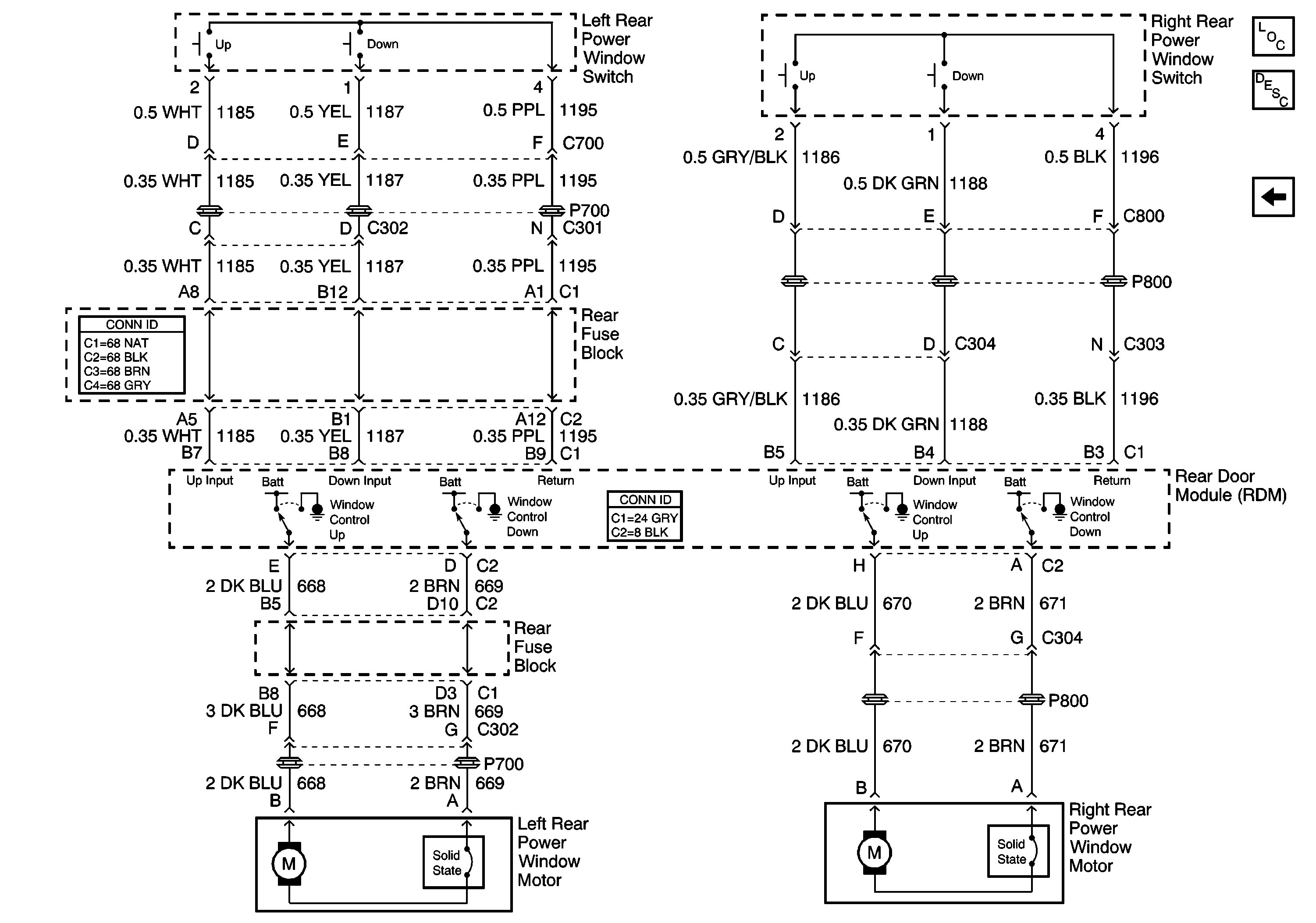Schematic
Refer to Power Window Schematics
Rear Power Window Components

.
Circuit Description
The circuit for the RR door power window switch consists of the following components:
| • | The RH rear power window switch |
| • | The rear door module (RDM) |
| • | The simple bus interface (SBI) |
| • | The driver door module (DDM) |
The RH rear power window switch provides input to the RDM. The RDM reports all switch activity in the form of SBI messages to the DDM. The diagnostic software for the DTC B2206 is contained in the DDM. The diagnostic program is run no less than once every 300 milliseconds. Faults involving the DDM or the SBI may set other DTCs and affect the operation of the power door locks and the outside mirrors.
Conditions for Running the DTC
| • | All modules in the circuit must be powered. |
| • | DTCs B1982 (battery voltage high) and B1983 (battery voltage low) must not be set as current DTCs. |
| • | All modules in the circuit must be communicating (no communications DTCs set as current). |
Conditions for Setting the DTC
DTC B2206 is set current if the SBI messages from the RDM indicate that the RH rear power window switch has been in the UP position for 15 consecutive seconds. This diagnostic will not run if either DTC B1982 (battery voltage high) or DTC B1983 (battery voltage low) are set current.
Action Taken When the DTC Sets
This DTC is dynamic and is current only when the fault is present. While DTC B2206 is current, the RDM will ignore actuation of the RH rear power window switch.
Conditions for Clearing the DTC
| • | This DTC will set from current to history when the window UP input cycles off. |
| • | The history DTC will clear after 50 ignition cycles. |
Diagnostic Aids
| • | A history DTC is evidence of an intermittent problem. |
| • | If DTC B2206 is current, cycle the ignition from OFF to RUN. If the DTC is still current, perform the following diagnostic. |
Test Description
The number(s) below refer to the step number(s) on the diagnostic table.
-
Check the module input state using the normal input status.
-
Check to see that the input is seen by the module.
-
Check to see that the signal lines to the module are open with the switch removed.
-
Check to see that the signal circuits are not shorted.
Step | Action | Yes | No |
|---|---|---|---|
1 | Did you perform A Diagnostic System Check - Door Systems? | Go to Step 2 | |
Does the scan tool display Idle? | Go to Step 3 | Go to Step 4 | |
Does the Door Window Switch parameter change from Idle to Up and Down? | Go to Diagnostic Aids | Go to Step 4 | |
Does the scan tool display Idle? | Go to Step 7 | Go to Step 5 | |
Test the signal circuits of the appropriate passenger door window switch for a short to ground. Refer to Circuit Testing and Wiring Repairs in Wiring Systems. Did you find and correct the condition? | Go to Step 10 | Go to Step 6 | |
6 | Inspect for poor connections at the harness connector of the appropriate passenger door control module. Refer to Testing for Intermittent Conditions and Poor Connections and Connector Repairs in Wiring Systems. Did you find and correct the condition? | Go to Step 10 | Go to Step 8 |
7 | Inspect for poor connections at the harness connector of the appropriate passenger door window switch. Refer to Testing for Intermittent Conditions and Poor Connections and Connector Repairs in Wiring Systems. Did you find and correct the condition? | Go to Step 10 | Go to Step 9 |
8 | Replace the appropriate passenger door control module. Refer to Door Control Module Replacement - Front or Door Control Module Replacement - Rear . Did you complete the replacement? | Go to Step 10 | -- |
9 | Replace the appropriate passenger door window switch. Refer to Front Door Switch Replacement or Rear Side Door Window Switch Replacement . Did you complete the replacement? | Go to Step 10 | -- |
10 |
Does the DTC reset? | Go to Step 2 | System OK |
